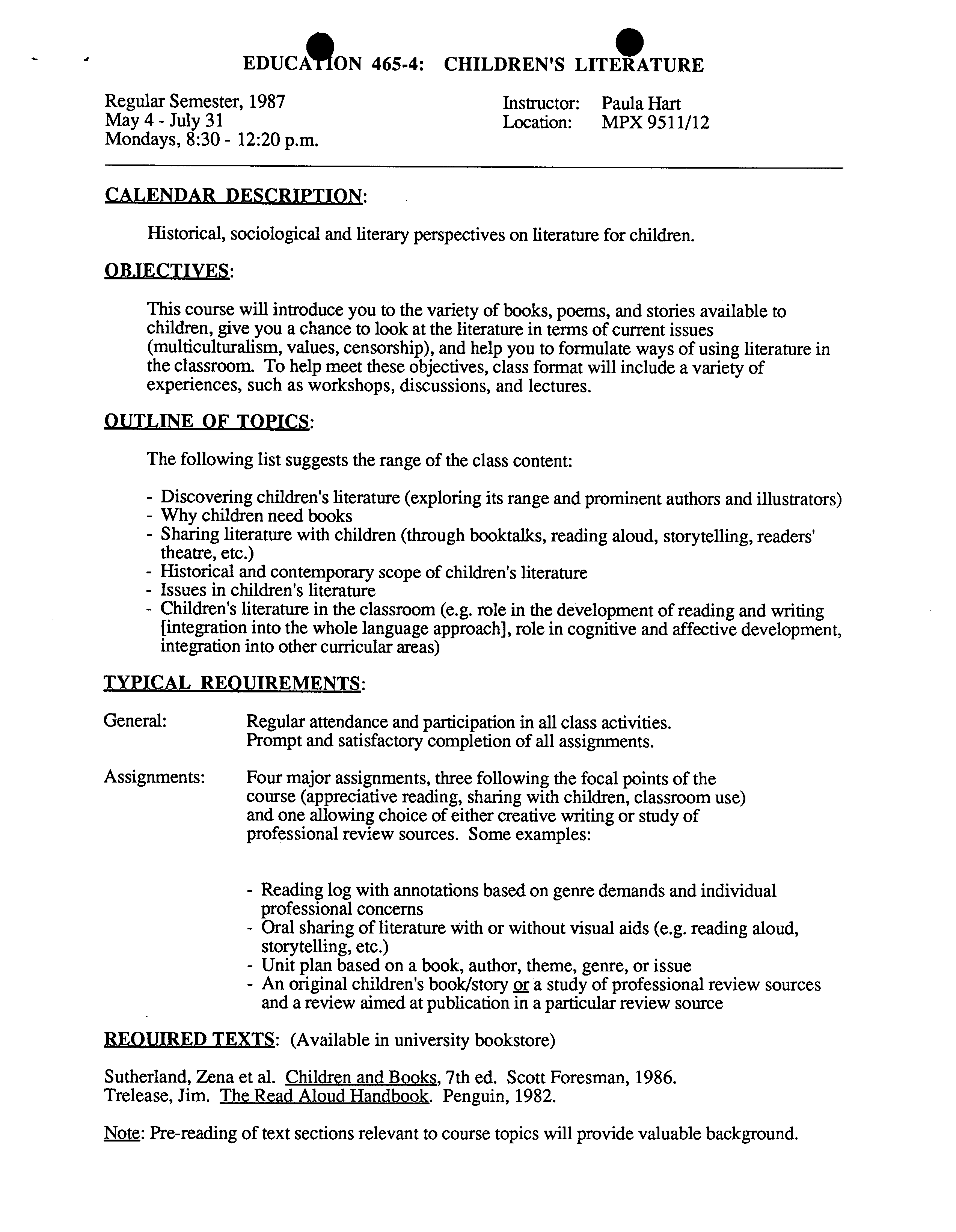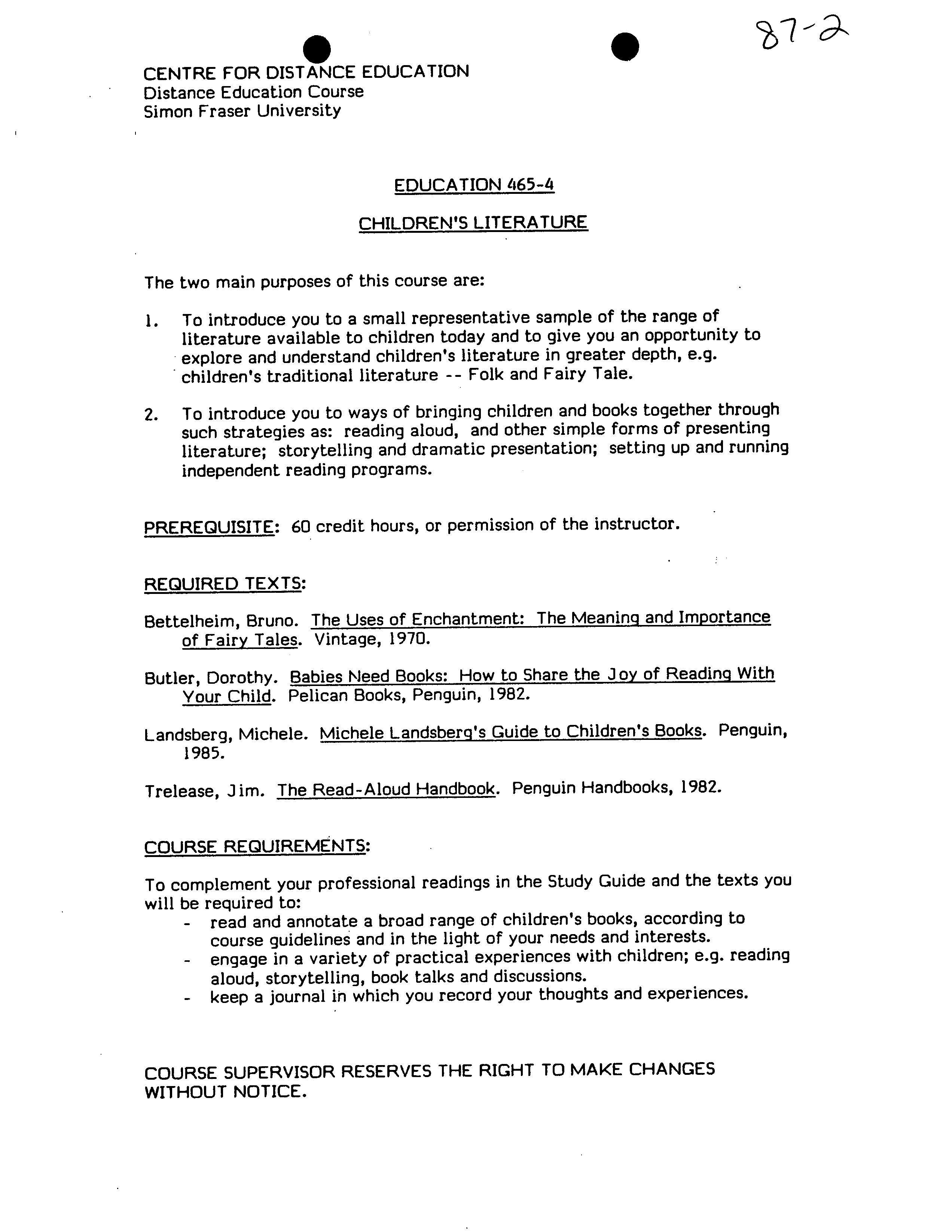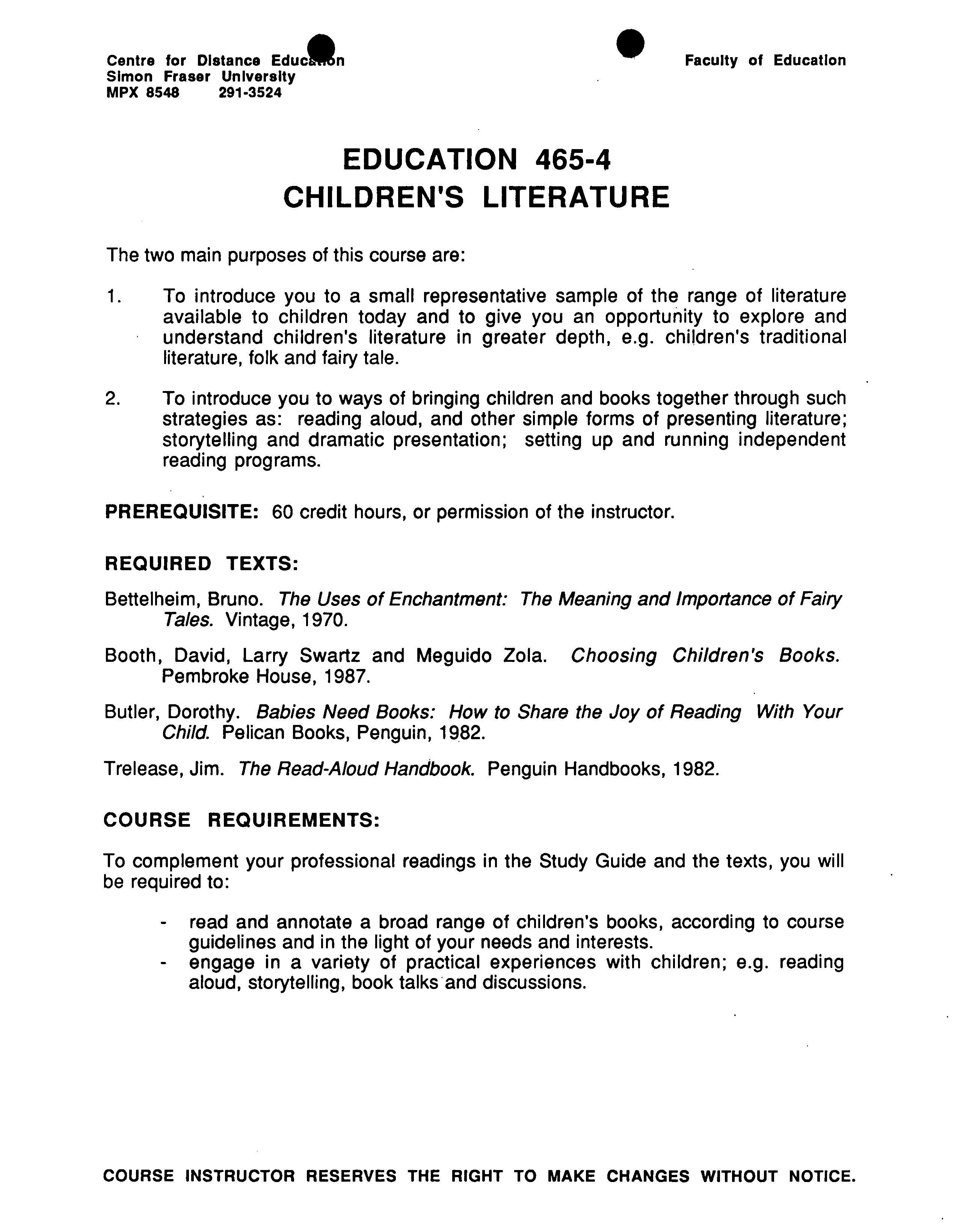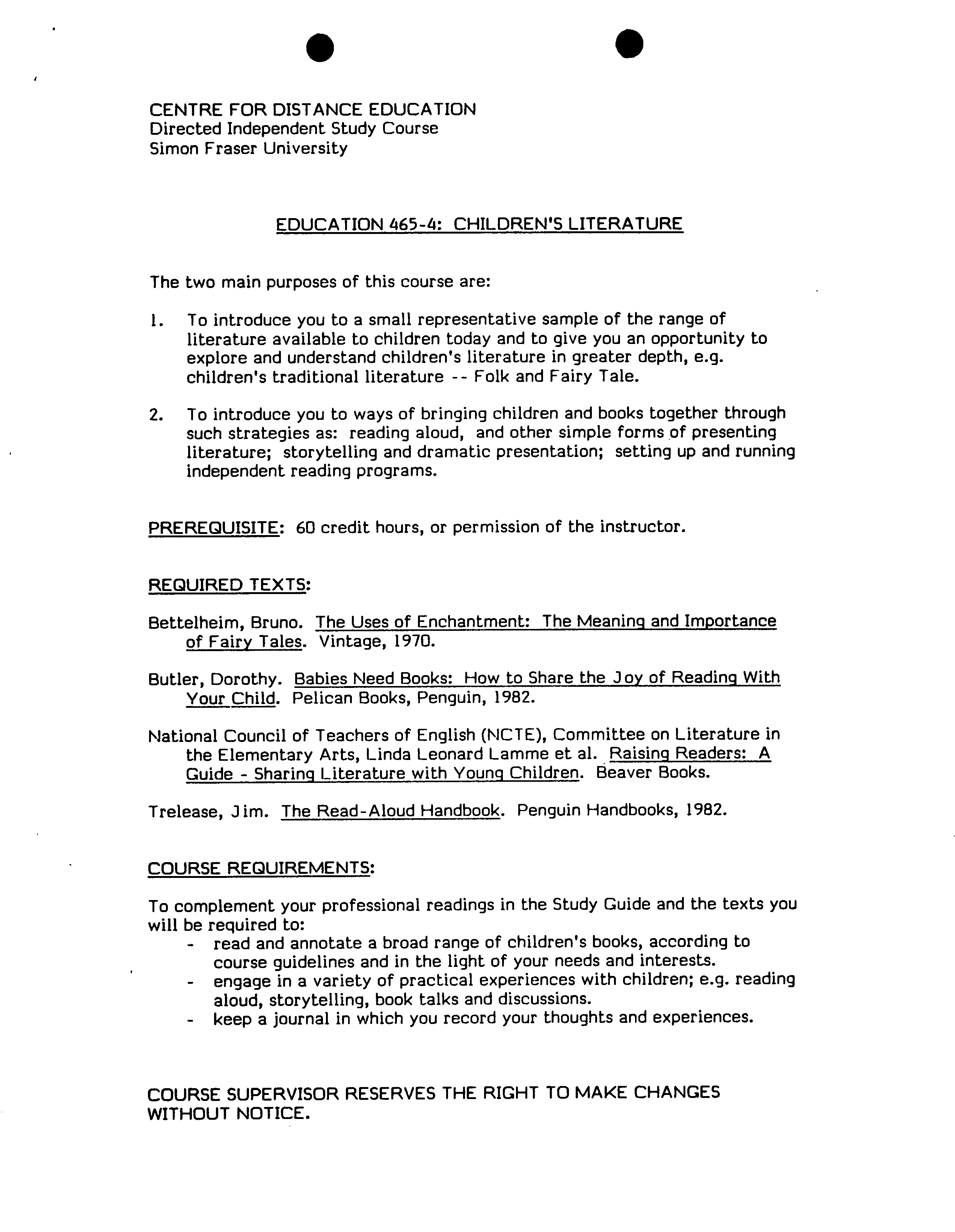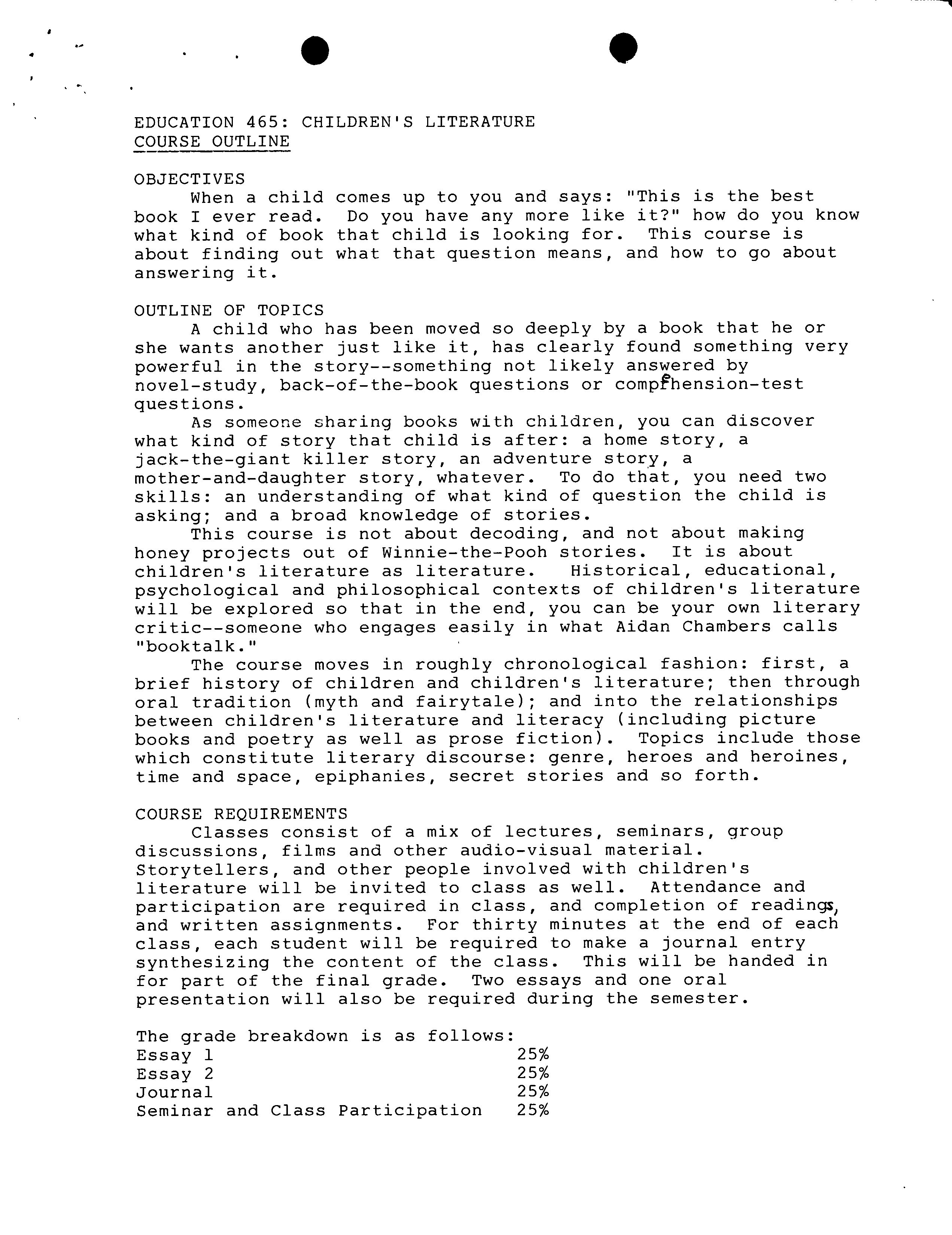EDUCA ON
465-4:
CHILDREN'S LITERATURE
Regular Semester, 1987
?
Instructor: Paula Hart
May 4- July 31
?
Location: MPX9511/12
Mondays, 8:30 - 12:20 p.m.
Historical, sociological and literary perspectives on literature for children.
This course will introduce you to the variety of books, poems, and stories available to
children, give you a chance to look at the literature in terms of current issues
(multiculturalism, values, censorship), and help you to formulate ways of using literature in
the classroom. To help meet these objectives, class format will include a variety of
experiences, such as workshops, discussions, and lectures.
The following list suggests the range of the class content:
- Discovering children's literature (exploring its range and prominent authors and illustrators)
- Why children need books
- Sharing literature with children (through booktalks, reading aloud, storytelling, readers'
theatre, etc.)
- Historical and contemporary scope of children's literature
- Issues in children's literature
- Children's literature in the classroom (e.g. role in the development of reading and writing
[integration into the whole language approach], role in cognitive and affective development,
integration into other curricular areas)
TYPICAL REQUIREMENTS:
General: ?
Regular attendance and participation in all class activities.
Prompt and satisfactory completion of all assignments.
Assignments: ?
Four major assignments, three following the focal points of the
course (appreciative reading, sharing with children, classroom use)
and one allowing choice of either creative writing or study of
professional review sources. Some examples:
- Reading log with annotations based on genre demands and individual
professional concerns
- Oral sharing of literature with or without visual aids (e.g. reading aloud,
storytelling, etc.)
- Unit plan based on a book, author, theme, genre, or issue
- An original children's book/story or a study of professional review sources
and a review aimed at publication in a particular review source
REQUIRED TEXTS:
(Available in university bookstore)
Sutherland, Zena et al. Children and Books, 7th ed. Scott Foresman, 1986.
Trelease, Jim. The Read Aloud Handbook. Penguin, 1982.
Note: Pre-reading of text sections relevant to course topics will provide valuable background.
•
.
::..c
-
.5 ::c?tT
:.'.s'')7
:'()
Lc:
?
011
?
:. ?
...
J*',
.
- ?
T
2P
'
2 ?
.'. ?
-.
?
":
?
.:
•s. ?
-
•
?
r ?
•j:
'' ?
.;
?
;': '
?
'
?
-f
2
.
?
•.
,
.1 ?
-. ?
'•
.
no
• ?
..
?
-.- ?
•
?
-.
tw-
r ?
s.
. ?
.
12' ?
• ?
•
? -:
[i'-•
J. ?
J3
ii
'' ?
i:';
,
?
;:'r
. ?
'.•
?
tTLf.
..:
Ins
02.
jrj ?
•i-.--
?
.: ?
.•
.
. ?
-
'U
t:)'"72) ?
'
.•
lu
InAsm
.1
4 ) OR
?
i'i ?
.
•
?
..
- ?
2
- ?
-.
?
3,.
. - ?
.11
.•
•
?
.
•
.
•
'-'
,
:
;ii'.
' ?
..
--••
?
.:;v ?
'
2JT''.?
-
?
-
S ?
.
CENTRE FOR DISTANCE EDUCATION
Distance Education Course
Simon Fraser University
EDUCATION 465-4
CHILDREN'S LITERATURE
The two main purposes of this course are:
1.
To introduce you to a small representative sample of the range of
literature available to children today and to give you an opportunity to
explore and understand children's literature in greater depth, e.g.
children's traditional literature -- Folk and Fairy Tale.
2.
To introduce you to ways of bringing children and books together through
such strategies as: reading aloud, and other simple forms of presenting
literature; storytelling and dramatic presentation; setting up and running
independent reading programs.
PREREQUISITE: 60 credit hours, or permission of the instructor.
REQUIRED TEXTS:
Bettelheim, Bruno. The Uses of Enchantment: The Meaning and Importance
of Fairy Tales. Vintage, 1970.
Butler, Dorothy. Babies Need Books: How to Share the Joy of Reading With
Your Child. Pelican Books, Penguin, 1982.
Landsberg, Michele. Michele Landsberg's Guide to Children's Books. Penguin,
1985.
Trelease, Jim. The Read-Aloud Handbook. Penguin Handbooks, 1982.
COURSE REQUIREMENTS:
To complement your professional readings in the Study Guide and the texts you
will be required to:
- read and annotate a broad range of children's books, according to
course guidelines and in the light of your needs and interests.
- engage in a variety of practical experiences with children; e.g. reading
aloud, storytelling, book talks and discussions.
- keep a journal in which you record your thoughts and experiences.
COURSE SUPERVISOR RESERVES THE RIGHT TO MAKE CHANGES
WITHOUT NOTICE.
Centre for Distance Educ•n
?
Faculty of Education
Simon Fraser University
MPX 8548 ?
291.3524
EDUCATION 465-4
CHILDREN'S LITERATURE
The two main purposes of this course are:
To introduce you to a small representative sample of the range of literature
available to children today and to give you an opportunity to explore and
understand children's literature in greater depth, e.g. children's traditional
literature, folk and fairy tale.
2. To introduce you to ways of bringing children and books together through such
strategies as: reading aloud, and other simple forms of presenting literature;
storytelling and dramatic presentation; setting up and running independent
reading programs.
PREREQUISITE:
60 credit hours, or permission of the instructor.
REQUIRED TEXTS:
Bettelheim, Bruno.
The Uses of Enchantment: The Meaning and Importance of Fairy
Tales.
Vintage, 1970.
Booth, David, Larry Swartz and Meguido Zola.
Choosing Children's Books.
Pembroke House, 1987.
Butler, Dorothy. Babies Need Books: How to Share the Joy of Reading With Your
Child.
Pelican Books, Penguin, 19.82.
Trelease, Jim.
The Read-Aloud Handbook.
Penguin Handbooks, 1982.
COURSE REQUIREMENTS:
To complement your professional readings in the Study Guide and the texts, you will
be required to:
- read and annotate a broad range of children's books, according to course
guidelines and in the light of your needs and interests.
- engage in a variety of practical experiences with children; e.g. reading
aloud, storytelling, book talks and discussions.
COURSE INSTRUCTOR RESERVES THE RIGHT TO MAKE CHANGES WITHOUT NOTICE.
.
CENTRE FOR DISTANCE EDUCATION
Directed Independent Study Course
Simon Fraser University
EDUCATION 465-4: CHILDREN'S LITERATURE
The two main purposes of this course are:
1.
To introduce you to a small representative sample of the range of
literature available to children today and to give you an opportunity to
explore and understand children's literature in greater depth, e.g.
children's traditional literature -- Folk and Fairy Tale.
2.
To introduce you to ways of bringing children and books together through
such strategies as: reading aloud, and other simple forms of presenting
literature; storytelling and dramatic presentation; setting up and running
independent reading programs.
PREREQUISITE: 60 credit hours, or permission of the instructor.
REQUIRED TEXTS:
Betteiheim, Bruno. The Uses of Enchantment: The Meaning and Importance
of Fairy Tales. Vintage, 1970.
Butler, Dorothy. Babies Need Books: How to Share the Joy of Reading With
Your Child. Pelican Books, Penguin, 1982.
National Council of Teachers of English (NCTE), Committee on Literature in
the Elementary Arts, Linda Leonard Lamme et al. Raising Readers: A
Guide - Sharing Literature with Young Children. Beaver Books.
Trelease, Jim. The Read-Aloud Handbook. Penguin Handbooks, 1982.
COURSE REQUIREMENTS:
To complement your professional readings in the Study Guide and the texts you
will be required to:
- read and annotate a broad range of children's books, according to
course guidelines and in the light of your needs and interests.
- engage in a variety of practical experiences with children; e.g. reading
aloud, storytelling, book talks and discussions.
- keep a journal in which you record your thoughts and experiences.
COURSE SUPERVISOR RESERVES THE RIGHT TO MAKE CHANGES
WITHOUT NOTICE.
. ?
.
EDUCATION 465: CHILDREN'S LITERATURE
COURSE OUTLINE
OBJECTIVES
When a child
book I ever read.
what kind of book
about finding out
answering it.
comes up to you and says: "This is the best
Do you have any more like it?" how do you know
that child is looking for. This course is
what that question means, and how to go about
OUTLINE OF TOPICS
A child who has been moved so deeply by a book that he or
she wants another just like it, has clearly found something very
powerful in the story--something not likely answered by
novel-study, back-of-the-book questions or comphension-test
questions.
As someone sharing books with children, you can discover
what kind of story that child is after: a home story, a
jack-the-giant killer story, an adventure story, a
mother-and-daughter story, whatever. To do that, you need two
skills: an understanding of what kind of question the child is
asking; and a broad knowledge of stories.
This course is not about decoding, and not about making
honey projects out of Winnie-the-Pooh stories. It is about
children's literature as literature.
?
Historical, educational,
psychological and philosophical contexts of children's literature
will be explored so that in the end, you can be your own literary
critic--someone who engages easily in what Aidan Chambers calls
"booktalk."
The course moves in roughly chronological fashion: first, a
brief history of children and children's literature; then through
oral tradition (myth and fairytale); and into the relationships
between children's literature and literacy (including picture
books and poetry as well as prose fiction). Topics include those
which constitute literary discourse: genre, heroes and heroines,
time and space, epiphanies, secret stories and so forth.
COURSE REQUIREMENTS
Classes consist of a mix of lectures, seminars, group
discussions, films and other audio-visual material.
Storytellers, and other people involved with children's
literature will be invited to class as well. Attendance and
participation are required in class, and completion of readings,
and written assignments. For thirty minutes at the end of each
class, each student will be required to make a journal entry
synthesizing the content of the class. This will be handed in
for part of the final grade. Two essays and one oral
presentation will also be required during the semester.
The grade breakdown is as follows:
Essay 1
?
25%
Essay 2
?
25%
Journal ?
25%
Seminar and Class Participation
?
25%
